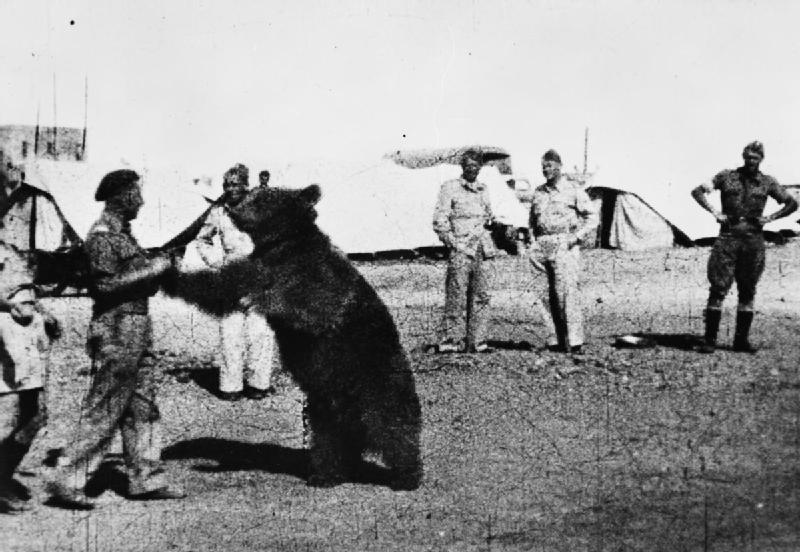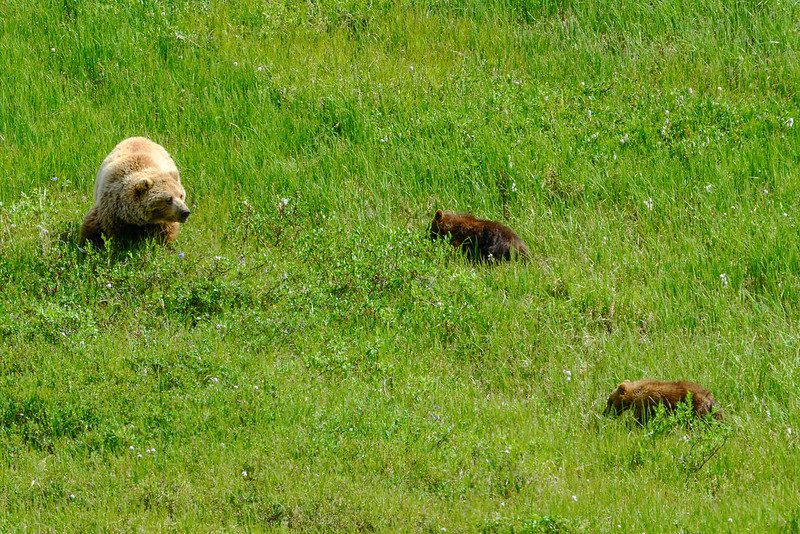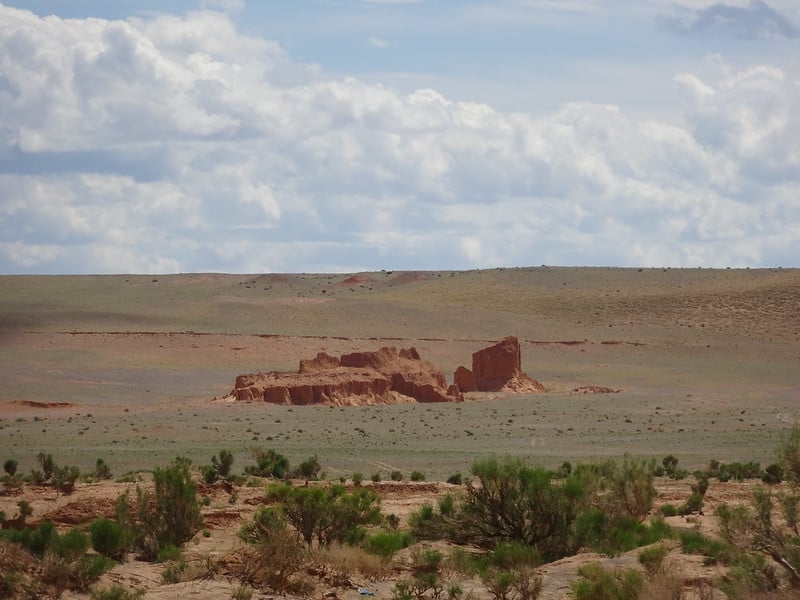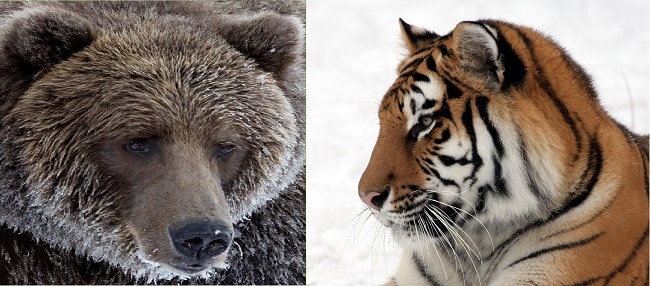| 1 | Eagles |
In an unfortunate fact of nature that some argue is a dark symbolic omen for the future World War 3, brown bears commonly eat eagles when they get the chance. Eagles might be ruthless hunting machines with their beaks and wings, but a bear has the advantage of being a bear, not to mention weighing ten times more.
A bear can break a eagle’s back with a single swipe of its paw and that’s what happened in 2016, as captured by 63 year old wildlife photographer Fred O’Hearn. The bear was defending a whale carcass by the shores of Kodiak Island, Alaska, and overcompensated slightly when two bald eagles arrived. One eagle was knocked to the ground, still alive, but unable to move due to skeletal injury. O’Hearn wished he could have crept forward and put the eagle out of its misery, but the sow was just too furious.
This youtube video shows a blond mother bear sneaking up on an eagle’s nest while its three cubs watch on curiously. She appears to be hungry for eggs, or maybe adult eagle meat itself, but is thwarted at the last minute when mother and father eagle fly free from the nest, soon to have a frank and honest discussion about the wisdom of buildings nests on the floor. The cubs just look confused, and it’s not clear whether the mother does find the nutritious eggs she seeks.
| 2 | Twinkies |
Until the 1960s, the bear laws were a lot looser in Yellowstone to put it mildly. The bear lunch platform was launched around the time of World War 1, where scores of bears would dine on scraps of old bacon while a guide on a horse rambled on about Yellowstone’s history. In 1915, cars were allowed inside Yellowstone park for the first time, and this marked the dawn of “holdup bears”, who saw massive hunks of moving steel and assumed that they contained just as many tasty treats as the garbage cans they raided.
Drivers were fine with this chance to see bears up close, and it gradually evolved into a tradition: before entering Yellowstone proper, parents and their children would stock up on Twinkies to toss from their car windows. The grizzlies and black bears gobbled them down in their hundreds. Peanut butter sandwiches and cheetos were more treats, until rising numbers of injuries (including one guy who kicked a grizzly and somehow lived) forced feeding bears to be banned outright.
Did Twinkies become the staple purely by chance? Maybe not, as there’s 350 calories per 100 grams, most of which are carbohydrates. To grizzlies, they probably taste like the world’s rarest type of berry, not least because of their soft, creamy insides.
| 3 | Beer |

Around 80 years ago, British troops were battling their way towards Rome, pushing back the waves of Axis troops as bullets flew over their shoulders in the battle of Monte Cassino. What’s weird is that for decades after this battle, the veterans swore to their families that they’d seen a large bear carrying artillery shells to the front line. It sounds like a hallucination under battle stress, but how could so many soldiers have the same delusion at once?
This bear was Wojtek, the Polish soldier bear, a Syrian brown bear who was rescued as an orphan and became the Polish army’s mascot. He slept in tents with soldiers, play wrestled with soldiers, and alongside swallowing cigarettes whole, one of his favourite foodstuffs was beer. Wojtek initially copied the hard-boozing habits of his soldier companions, before coming to love the beverage himself.
Instead of sipping it like a gentlemen, Wojtek used to gulp down the entire can in one go and peer into its metal depths to see if there was any left. He never once got drunk, despite drinking dozens of cans in one go. One time, the unit was stationed in Palestine, and when Wojtek walked into the munitions store, he frightened a thief into screaming, who was later caught. Wojtek’s reward was a bottle of beer. “For him one bottle was nothing, he was weighing 440 pounds” said his former comrade Wojciech Narebski.
| 4 | Earthworms |

It doesn’t matter if it’s a pelican, a moose, or the last surviving stegosaurus that nobody has noticed. If a food is rich in protein, then a grizzly bear will eat it, and that applies with full force to earthworms. Despite being slippery and elusive, grizzly bears have been recorded eating earthworms multiple times, most notably in the two-season TV series Yellowstone Live broadcast on National Geographic back in 2018. It showed a mother bear scooping at the earth while her cubs watched and imitated her, learning from their teacher, before one struck slimy gold and swallowed it.
For years, this was a mysterious question. A study in Yellowstone from 1977 to 1992 spotted grizzlies eating earthworms 20 times, and a 2002 study suggested that worm-loving grizzlies do all their feeding before June, when the soil is still soft from the melting snowpack. Similarly, the bears hunted for worms more in months with higher rainfall.
Earthworms are 60-70% protein, and at 2 digging sites which scientists monitored at Yellowstone, there were 120-170 earthworms per square meter. That translates to 4000-7900 worms across the feeding ground. Bears are well accustomed to strenuous digging for roots such as American sweetvetch – that’s what their massive muscular hump and longer claws are for.
| 5 | Apples |

Bears love apples, and unlike humans, they eat the entire thing, including the seeds, before doing their bit in the circle of life and spreading them around. There’s no taking two huge bites and thorwing the rest over your shoulder straight into the bin.
Apples are so popular with brown bears that they’re being used to save the Marsican version from extinction. This central Italian subspecies numbers 60-80 and local villagers have taken to pruning the local apple trees. Firstly, this helps by keeping bears away from sheep and honey and preventing an inevitable bullet to the head. Secondly, and more simply, it gives the bears some extra calories, to prevent death from starvation during hibernation (Italy isn’t exactly a salmon capital). As we speak, volunteer task forces with the grizzled appearance of SAS soldiers are marching around Italy with shears in hands.
Likewise, the endangered Cantabrian brown bear of northern Spain gets 15% of its calories from apples in the autumn, and a huge tree planting campaign is being mobilised. The 15,000 trees are set to include apple, cherry, alder buckthorn, and chestnut trees.
Black bears love apples as well. See this video from the Kilham rescue centre in New Hampshire, with 5 black bears sitting around a gigantic pile of applies looking like a McDonald’s ball pit (but with less snakes). The bears are moaning with joy.
| 6 | Wild rhubarb roots |

There are few places on Earth bleaker than the Gobi desert, where nothing grows and nothing survives and no noises can be heard except perhaps the very faint scuttering of spiders. The Gobi desert lies in Mongolia and is a cold desert where the average January temperature is -26.5C. There are no elk and absolutely no salmon, but a rare species of bear called the Gobi bear lives here, sharing its terrain with camels. It’s one of the smallest subspecies, and is perfectly adapted to desert life, starting with its soil-coloured fur, and continuing with an obsession over wild rhubarb.
Gobi bears spend much of their time digging through the soil to unearth this plant’s starchy roots, as it’s one of the few plants that prospers in the bleak Gobi landscape. It’s a lot of work compared to the salmon buffet of Kodiak island, but the Gobi bear has no choice, and wild onion roots are another staple, which are far smaller than the table onions which make you cry when you cut them.
These hardy plants are supported by inaccessible underground desert springs, and a tiny trickle of precipitation that makes it over the Himalaya each summer during monsoon season and fizzles out over the Gobi desert’s southern half. Gobi bears also eat lizards, beetles and wingless grasshoppers.
| 7 | Tigers |
 In our article on interspecies conflict, we discussed how Siberian tigers and the Ussuri brown bear subspecies commonly come to blows in east Asia. Another fun fact is that when bears win, they commonly devour the tiger’s carcass. In a 1973 study on 12 brown bears, they ate every tiger they slew without fail, including adult males, adult females and cubs. It works in reverse as well, as tigers love to feast on the fatty sections of a bear’s body.
In our article on interspecies conflict, we discussed how Siberian tigers and the Ussuri brown bear subspecies commonly come to blows in east Asia. Another fun fact is that when bears win, they commonly devour the tiger’s carcass. In a 1973 study on 12 brown bears, they ate every tiger they slew without fail, including adult males, adult females and cubs. It works in reverse as well, as tigers love to feast on the fatty sections of a bear’s body.
No footage exists of these events, due to the vastness of the Russian taiga and elusive nature of the Siberian tiger. But supposedly, a Siberian tiger gets 2.1% of its yearly calories from brown bears (also including Asiatic black bears). Additionally, 35% of tiger kills are stolen in some form by bears, whether entirely or as small parts in a token peace offering. It’s almost certain that after leaving their hibernation dens, Ussuri brown bears eat the defrosting carcasses of tigers which have died of old age over the winter.
These confrontations only happen in one narrow region, the far north-east of China and southeast of Russia, the only place on Earth where tigers and brown bears naturally overlap.
| 8 | Dandelions |
To a grizzly bear, stumbling on a field of dandelions is like finding a magical forest where candy grows on trees. Many human beings are steaming wild dandelions these days as new data emerges showing that they’re rich in carotenoid antioxidants, but bears are well ahead of the game. Yellowstone is a particular buffet, according to a study released in 2014. It found that since the 1970s, the average Yellowstone grizzly’s garbage consumption has plummeted to zero. In its place, the main foods are now plants like grasses, clovers and dandelions, followed by hooved animals.
Alaska meanwhile, has 9 different species of dandelion, 5 of which are found in Denali national park, a hotspot of brown bears (with a strangely high proportion being blond). The only one which shouldn’t be there is Taraxacum officinale, the common dandelion, which is an invasive species in Denali and the focus of an annual “dandelion demolition” where 100s of pounds are uprooted.
With only 25 calories per 100 grams, bears will never spend the entire summer eating dandelions like they do with berries and salmon, but it’s common to see both grizzly and black bears mindlessly eating these universal flowers. The yellow petals are particularly nutritious. This video shows a Yellowstone grizzly in full dandelion-munching action.
| 9 | Doughnuts soaked in bacon grease |

Storm clouds appeared in 2020 when the federal government announced that several bear hunting techniques were to be loosened, with control handed back to the Alaskan state government. The barbaric practises included breaking into mother bears’ winter dens, blinding bears with spotlights, and luring grizzlies to baiting stations with doughnuts covered with bacon grease in order to shoot them at point blank range.
This doughnut recipe is a favourite among hunters. It’s a time-tested, reliable method, and with the donuts being sweet, it has the advantage of attracting bears but not being stolen by meat-exclusive wolves. This bombshell of a bait recipe was legalised back in 2005 to help boost the moose population, which bears preyed on, before the Obama administration outlawed the recipe in 2015.
Donut holes are equally popular, the portion cut out of the middle and sold separately. In 2017, a man was fined 2000 Canadian dollars and slapped with a 6 month restraining order (forcing him to stay 164 feet from bears) after he posted loveable footage of himself feeding bears along the Alaska highway. The bears appeared to love the donut holes so much that they didn’t take 2 of the man’s fingers with them. Then there was an intelligence study, where the bears were tasked with grabbing a donut dangling from a clothes wire, by repositioning a plastic box beneath it.
| 10 | Peanut butter jelly sandwiches |
Not long ago, the widely respected (and feared) don of Arizona bears was Albert the rescue bear, who resided at the Lions, Tigers and Bears centre. He was rescued from a roasting concrete pit in North Carolina alongside his sister Cherry Bomb, in cruel scenes more typical of an Iranian zoo than America.
Albert displayed many skills in his new forever home, including cracking coconuts open against the rocks to extract the sweet water within. He had a habit of ripping open his Christmas presents with his snout and looking like he had wrapping paper for skin. But Albert’s biggest love was easily peanut butter sandwiches, and over the years he kept his guests entertained by the dozen as his feeders fed them to him. Albert died in 2019, but his playmate sister Cherry Bomb lives on.
Outside the grizzlyverse, a black bear made global headlines when it sat down at a picnic bench in Arizona, and a camouflage jacketed guy rushed over with his knife and began carving out a peanut butter sandwich. He even warned the bear to be patient, which sat down at the table as though part of the family. This love of PBJ sandwiches seems universal among bears, although social media warned that the black bear was addicted to human food and had a strong chance of being shot one day.

Leave a Reply